 The USGA’s U.S. Open is, without question, the most difficult tournament in golf. Since its inception in 1895 thirty-two winners have been decided in playoffs. The first playoff was won by Willie Anderson of Scotland in 1901. An eventual four-time U.S. Open winner, Anderson won three U.S. Opens in a row from 1903 to 1905. It is a record that still stands. Hard living Anderson died at age thirty of “hard living.”
The USGA’s U.S. Open is, without question, the most difficult tournament in golf. Since its inception in 1895 thirty-two winners have been decided in playoffs. The first playoff was won by Willie Anderson of Scotland in 1901. An eventual four-time U.S. Open winner, Anderson won three U.S. Opens in a row from 1903 to 1905. It is a record that still stands. Hard living Anderson died at age thirty of “hard living.”
What Willie Anderson and eventual 1906 U.S. Open victor Alex Smith did well over one-hundred years ago in their playoff has been repeated many times.
Number Five: Lee Trevino over Jack Nicklaus, 1971
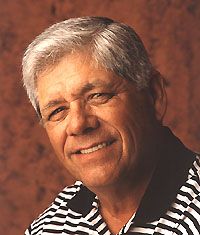 Crowds flocked to watch Lee Trevino in his prime as much for his one-liners as his golf. “Nice shot,” a fan once said. “What did you expect from the U.S. Open champion – ground balls?” Lee responded.
Crowds flocked to watch Lee Trevino in his prime as much for his one-liners as his golf. “Nice shot,” a fan once said. “What did you expect from the U.S. Open champion – ground balls?” Lee responded.
On the first tee of Trevino and Nicklaus’ playoff hole in the 1971 Trevino remembered that his daughter had left a toy in his golf bag. He took the rubber snake (which Nicklaus had seen coming) out and tossed it at Nicklaus’ feet. They both laughed but the message had been sent. Trevino was a scrapper who wasn’t above a little gamesmanship. It was an act that many thought was below the game. Golf was both a game and a stage for Trevino.
Nicklaus found sand on the second and third holes which ended up allowing Trevino a two-stroke lead. He was never able to catch Trevino. Nicklaus shot a respectable 71 to Trevino’s 69.
Trevino is the only player to have won three national opens in one year. He won the U.S. Open, Canadian Open, and the British Open in 1971.
Number Four: Ben Hogan over Lloyd Mangrum and George Fazio, 1950
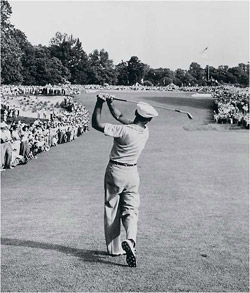 1950 was a big year in golf. Jimmy Demaret won a third Masters, Sam Snead won eleven PGA Tour events, and Ben Hogan won the U.S. Open.
1950 was a big year in golf. Jimmy Demaret won a third Masters, Sam Snead won eleven PGA Tour events, and Ben Hogan won the U.S. Open.
Every morning Hogan would begin his morning ritual. He soaked in a tub of hot water and Epsom salt, took some pain killers, and wrapped his legs to keep the swelling down. It was a year after the accident that nearly took his life and he wasn’t in great shape.
Hogan’s caddy retrieved his ball from the cup to alleviate the strain of bending down to get it. Hogan’s three-stroke lead evaporated by the time he reached the long par-four final tee in the final round. He was physically spent. And yet somehow he pulled off that amazing one-iron (professional Jackson Bradley believes it was Hogan’s strong two-iron) into the final green which set up Hogan’s two-putt to get into the playoff.
In the playoff Hogan shot a 69, Mangrum a 73, and Fazio a 75. Mangrum famously marked his ball, picked it up to get an insect off, and was awarded a two-stroke penalty. Marking one’s ball was against USGA’s rules at the time. Hogan later said, “The 1950 Open was my biggest win. It proved I could still play.”
Number Three: Jack Fleck over Ben Hogan, 1955
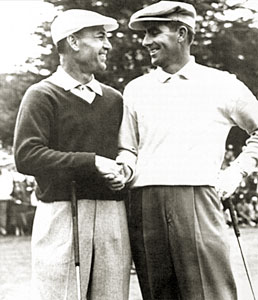 Fleck’s unlikely victory over Ben Hogan in the 1955 U.S. Open denied Hogan a record five U.S. Opens. “I knew Ben Hogan in the years previous to the ’55 Open,” said Fleck, “but he didn’t know me. He was my secret idol.” Fleck watched Hogan hit shots in practice rounds and did his best to imitate the man he respected so much. “I copied him and actually did him one better: I began pacing off yardage, which nobody else had done to that point,” said Fleck. And one more thing: he did him one one better in the ’55 Open.
Fleck’s unlikely victory over Ben Hogan in the 1955 U.S. Open denied Hogan a record five U.S. Opens. “I knew Ben Hogan in the years previous to the ’55 Open,” said Fleck, “but he didn’t know me. He was my secret idol.” Fleck watched Hogan hit shots in practice rounds and did his best to imitate the man he respected so much. “I copied him and actually did him one better: I began pacing off yardage, which nobody else had done to that point,” said Fleck. And one more thing: he did him one one better in the ’55 Open.
NBC proclaimed Hogan the winner before Fleck was off the course. He was on his 71st hole down only one. Oops. Fleck went on to beat his idol in a playoff with a 69 to Hogan’s 72.
Fleck was good friends with Hogan, as close as anyone could get to the stoic character. Hogan had made Fleck the golf clubs that he used to beat him in the Open. While it was Fleck’s only major championship victory, he didn’t back into it, nor did he win it over a skill-less opponent.
Number Two: Jack Nicklaus over Arnold Palmer, 1962
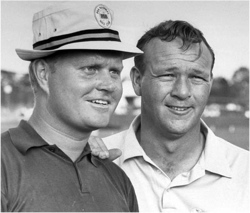 Fresh off a 1962 Masters Playoff victory against Gary Player and Dow Finsterwald, Arnold Palmer met new professional Jack Nicklaus at the U.S. Open at Oakmont Country Club. Palmer said later, “My first emotion when I think about that week was that I really wanted to win at Oakmont. It was the first for me playing golf in Pittsburgh. I had played it quite a lot, felt like it was almost my home course.”
Fresh off a 1962 Masters Playoff victory against Gary Player and Dow Finsterwald, Arnold Palmer met new professional Jack Nicklaus at the U.S. Open at Oakmont Country Club. Palmer said later, “My first emotion when I think about that week was that I really wanted to win at Oakmont. It was the first for me playing golf in Pittsburgh. I had played it quite a lot, felt like it was almost my home course.”
Both players finished the 72nd hole at 283. Nicklaus’ tally was 72-70-72-69 and Palmers’ was 71-68-73-71. Nicklaus shot a 71 and Palmer a 74 in the playoff. Arnie’s Army could do nothing but watch their hero fall to the up-and-coming Nicklaus. Nicklaus’ long and accurate driving coupled with his impeccable putting stroke were an advantage.
Nobody knew that a rivalry was about to be born; one in which Nicklaus would get the upper hand. Nicklaus’ 1962 U.S. Open victory was the first of an eventual 18 major championships. It was his first victory as a professional.
Number One: Francis Ouimet over Harry Vardon and Ted Ray, 1913
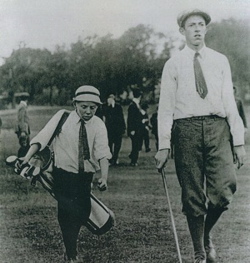 Francis Ouimet is a central figure in American golf. He won a total of twelve events, including his famous U.S. Open in 1913. His other victories include six Massachusetts State Amateurs (1913, 1914, 1915, 1919, 1922, 1925), two U.S. Amateurs (1914, 1931), one French Open Amateur (1914), one Western Amateur (1917), and one North and South Amateur (1920). Ouimet’s was an amateur in all of his victories.
Francis Ouimet is a central figure in American golf. He won a total of twelve events, including his famous U.S. Open in 1913. His other victories include six Massachusetts State Amateurs (1913, 1914, 1915, 1919, 1922, 1925), two U.S. Amateurs (1914, 1931), one French Open Amateur (1914), one Western Amateur (1917), and one North and South Amateur (1920). Ouimet’s was an amateur in all of his victories.
Ouimet was twenty years old in the 1913 U.S. Open and his caddy, Eddy Lowry, ten. It was an unlikely pair, one that would garner more than a little attention in our day as it did then.
Harry Vardon and Ted Ray, the players Ouimet defeated in the 18-hole playoff, were well-known professionals and formidable opponents. If Ouimet had an advantage it was that he had caddied The Country Club in Brookline, Massachusetts growing up.
Ouimet birdied the 71st hole to get into a playoff with Vardon and Ray and defeated them, as the rain pelted down, with a 72. Vardon shot a 77 and Ray a 78.
When Francis Ouimet entered the 1913 U.S. Open golf wasn’t enjoyed by anyone but the upper-class. His victory brought golf to the nation and earns him the top U.S. Open playoff spot.
Photo Credits: © Golf Legends, Hy Peskin/SI.com, Jack Fleck Golf, Mike McAllister/SI.com, Ultimate Disney.
I am an avid golfer — not a very good one (8 hc), but I dearly love the game. The Francis Ouimet story is just timeless. My dream is to some day play with my adult children (who also love the game) The Country Club Course that he won the championship on.
I can’t stop watching the movie..” The Greatest Game Ever Played ”…….It is the best sports movie ever made. I clap I cry every time I see it.
What a great movie the greatest game ever played is. I wish i was around back in those days to something like that for my self
CBC aired the movie tonight And I Watched it 3 times at different time slots… One of the best underdog stories ever done … I rate the movie 6 stars out 5….
I’m trying to confirm a story I heard about Trevino and Nicklaus: One tournament day Nicklaus turns to Trevino as Nicklaus is about to hit and says, “now, we don’t have to talk today.†To which Trevino replies, “Oh, you don’t have to talk, Jack. You just have to listen.â€
Anybody know the details or can help me verify it?